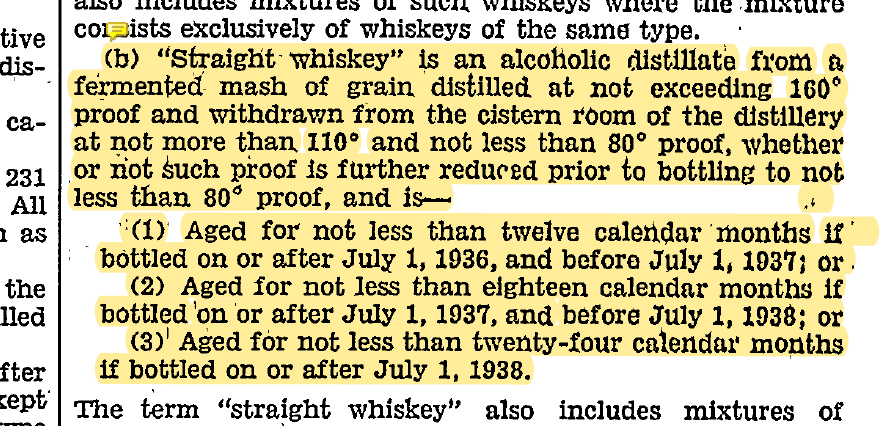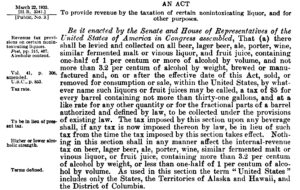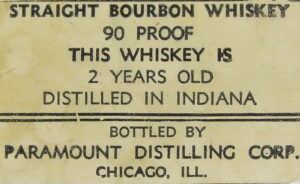
Easily achieved today, aging for two years was a new standard in 1936, but why?
As an historian cum archeologist of American whiskey I maintain something of a ‘wish list’ of unanswered questions that I hope one day to get resolved. Many of these hinge on locating source documents the federal government didn’t think important enough to make available (or easily found) on-line. (I’m looking at you, Treasury Department!) A bunch of them have to do with how the current standards of identity for American whiskey (AKA 27 CFR 5) were arrived at after the repeal of Prohibition. Many of these questions will likely never be answered since there’s no record of who wrote the standards or what reasoning those ‘framers’ might have used to arrive at them [1].
Perhaps the most nagging of my questions has been trying to understand why the definition of ‘straight’ as a qualifier of whiskey changed in meaning so radically when the standard was written. I wrote about this at length already but didn’t see the matter as closed only the question explored. But I now actually think I have a satisfactory answer. Or at least one that better reflects the needs of the moment in which the standard was written and its likely intended purpose back in 1938. That answer came finally as the result of another investigation: looking into what befell whiskey production in the run up to and during the second world war.
Filling in a gap…
About a month ago, a co-worker shared a story with me they had heard about the kind of whiskey was being provided to G.I.s during World War II. I knew beverage alcohol was impacted by the war but realized I had a gap in my master bibliography on whiskey legislation enacted before and during that period. Fortunately, that turned out to be not terribly hard to remedy [2].
I learned that from 1941 to 1945 the federal government (under the authority of the Civilian Production Administration for the War Production Board) began to oversee alcohol production. This was to ensure there would be enough alcohol available for the impending war effort, primarily as fuel for torpedoes but also for the production of gunpowder, synthetic rubber and (surprisingly) penicillin. Initially such ‘industrial alcohol’ was made by distilleries specializing in its production using molasses as feedstock. But when war demand was predicted to outstrip molasses supply, the government started to look into to beverage alcohol made from grain, i.e. whiskey, to fill the gap. Of course, grain was also in short supply during the war, another constraint to manage. Eventually the entire production of the beverage alcohol industry would be diverted to the war cause.
With all alcohol production turned to the war, beverage companies like Seagram and Schenley resorted to bottling blended whiskey to help stretch existing stocks of aging Bourbon (and rye). These stocks had just barely begun to be be replenished after the repeal of Prohibition in 1933. Blends would have been a combination of some amount of young whiskey (typically 20-30%) and high-proof unaged neutral spirits. When the federal government granted a series of one month ‘distilling holidays’ during the war to allow distilleries to produce limited amounts of beverage alcohol, they would naturally have just made neutral spirits as these could be used immediately for bottling more blended whiskey [3].
Connecting the dots…
As I thought about the war situation more, it occurred to me that whiskey old enough to qualify for Bottled-in-Bond labeling, which had to be at least four years old [4], would be practically non-existent during this time. This standard of quality, created in 1897 with the help of E.H. Taylor and then Secretary of State William Carslile, had only gained real traction (somewhat ironically) during Prohibition.
Exiting Prohibition, however, the beverage alcohol business needed a complete reboot. There would not have been a lot of whiskey still in wood long enough to meet the old Bottled-in-Bond standard [5]. In fact, some of the last bottles of medicinal whiskey released at the end of Prohibition were blends of younger whiskey, sometimes mixed with neutral spirits, sometimes with older whiskey, bottled at lower proof. And here, at last we see the real value proposition of the (then new) standard of for straight whiskey: it was a quality distinction that could be placed on labels relatively quickly after Repeal in 1933.
The case for ‘straight as an attainable standard’ makes even further sense when we look at the original wording for it as it appeared in 1936:

In other words, even the two year mark would have been a bit out of reach for whiskey distilled shortly after Repeal in 1933 [6]. So the ‘straight’ standard included an easement reflecting this shortfall. This would have given restarted distilleries time to meet the new two-year requirement. By 1938 the easement would have expired and so it was subsequently deleted from the ‘straight’ standard we see today in 27 CFR 5.
Seen in this context (limited stocks of sufficiently aged whiskey and a public now accustomed to the Bottled-in-Bond standard), creating a more easily achieved intermediate distinction back in 1936 (‘aged for at least two years’) would have been of great value to the recovering whiskey business.
This still leaves the question of why the standard was designated ‘straight’ (which had a specific meaning already) and not something else. My thinking is that it would have resonated with older whiskey drinkers who would have remembered when the term had been previously used (albeit without formal/legal definition) to distinguish whiskey distilled from grain and aged in wood, from ‘compound whiskey’ made from cheaper molasses-based spirits then flavored and colored with additives [7].
The value and purpose of the ‘straight’ standard becomes less apparent as we head into the 1950s, with the constraints of World War II and Prohibition receding in the rear view mirror. In fact, the beverage alcohol business would soon face almost the exact opposite problem as tastes shifted to vodka and light rum: increasing stocks of ever older unsold whiskey, whiskey that would soon be coming out of bond and for which an oppressively large tax bill would be due…but that’s a story for another day.

—
NOTES:
[1] Honestly, its an odd absence in the record given the U.S. government’s propensity to document all its legislative doings no matter how insignificant. And yet, no trace appears to remain.
[2] Some of what follows about whiskey production during World War II was sourced from posts to bourbonenthusiast.com in 2008. I also found an amazingly comprehensive and helpful report published in 1945 by the Civilian Production Administration entitled Alcohol Policies of the War Production Board and Predecessor Agencies, May 1940 to January 1945.
[3] Also consider that all distilleries operating at this time had been ‘re-tooled’ to distill alcohol at the highest possible proof. It simply wasn’t practical to distill at the lower proof (for more flavorful spirit) needed for whiskey during these short periods.
[4] The four year minimum age requirement was not part of the original 1897 legislation. It was mandated in 1911 by new legislation entitled AN ACT To allow the bottling of distilled spirits in bond.
[5] Also a lot of what remained to be bottled at this time, having been distilled 16 or more years earlier, was approaching levels of woodiness that rendered it close to undrinkable. Not that anyone would have rejected it during Prohibition. (NOTE: Prohibition ran for 13 years starting in 1920 but distillation of beverage alcohol had already been suspended three years earlier in 1917 as part of the Lever Food and Control Act. Grain supplies became constrained after the U.S. entered the first World War that same year and it was felt these would be better used for food.)
[6] It’s worth nothing that all six holders of medicinal whiskey permits were entitled to distill in when the government approved a ‘holiday’ from Prohibition in 1929. However only one functional distillery remained at the time: Stitzel in Louisville, KY. Both Frankfort Distilling Company (AKA Four Roses) and Brown-Foreman chose to have Stitzel make whiskey for them under contract. That whiskey would have been old enough to qualify as ‘straight’ by 1935, assuming it hadn’t already been bottled.
[7] If Prohibition had one positive result, it was that it destroyed the market for rectified (hence defined as ‘compound’) whiskey once and for all. The animosity between distillers and rectifiers that had led first to the Pure Food and Drug Act of 1906 and then the ‘Taft Decision’ in 1909 was rendered pointless by the 18th Amendment and honestly forgotten by the ratification of the 21st.



